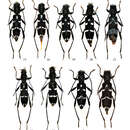Amamiclytus yulongi
(
Neerlandês; Flamengo
)
fornecido por wikipedia NL
Insecten Amamiclytus yulongi is een keversoort uit de familie van de boktorren (Cerambycidae). De wetenschappelijke naam van de soort werd voor het eerst geldig gepubliceerd in 2011 door Niisato & Han.[1]
Bronnen, noten en/of referenties Geplaatst op:
16-02-2014
Dit artikel is een beginnetje over biologie. U wordt uitgenodigd om op bewerken te klikken om uw kennis aan dit artikel toe te voegen.

- licença
- cc-by-sa-3.0
- direitos autorais
- Wikipedia-auteurs en -editors
Description
(
Inglês
)
fornecido por Zookeys
Male and Female. Body length (from vertex to apices of elytra) 4.0–4.7 mm in ♂, 4.9–5.1 mm in ♀. Colour almost as inAmamiclytus junisp. n., though more strongly glossy on elytra. Hairs and pubescence almost as inAmamiclytus junisp. n.; head more densely clothed with pale gray pubescence on frons in both sexes; antennae densely with pale pubescence on segments 4–11; pronotum thinly with pale hairs, sparsely with pale gray pubescence; elytra densely with light brown pubescence throughout, Bvery sparse, Son basal tenth relatively small and oblong, Laon basal third semicircular, almost always isolated, rarely arcuate and attaining toS, Lpon apical 2/5 more or less narrow, almost transverse, Anot so narrow;MslandMssdistinct, Mtamoderately pubescent, not so dense;V1as inAmamiclytus junisp. n., V2distinct, V3andV4sometimes disappeared.
Head almost as inAmamiclytus junisp. n., though more densely finely punctured, with a thin feeble median line on frons; HW/PW 0.80–0.94 (M 0.88) in ♂, 0.71–0.95 (M 0.86) in ♀. Antennae as inAmamiclytus junisp. n. Pronotum almost as inAmamiclytus junisp. n.; disc gently convex throughout, especially raised near middle of basal margin, with punctationdeeper and slightly large; PL/PW 1.06–1.11 (M 1.09) in ♂, 0.92–1.33 (M 1.08) in ♀, PB/PA 0.93–1.00 (M 0.95) in ♂, 0.80–0.94 (M 0.88) in ♀, PW/EW 0.80–0.90 (M 0.85) in ♂, EL/PL 2.75–3.22 (M 2.93) in ♂, 2.57–3.40 (M 3.04) in ♀, 0.70–0.85 (M 0.79) in ♀. Scutellum as inAmamiclytus junisp. n. Elytra almost as inAmamiclytus junisp. n.; sides gently arcuate at a level between basal eighths and apical fourth; disc with sparse but more or less deep punctation; EL/EW 2.48–2.90 (M 2.71) in ♂, 2.34–2.83 (M 2.54) in ♀. Ventral surface almost as inAmamiclytus junisp. n., though more sparsely punctured on abdomen; anal ventrite in ♂ more or less triangularly produced at middle of apical margin. Legs almost as inAmamiclytus junisp. n., though exceeding elytral apices at apical tenth.
Male genitalia. Basically similar to those ofAmamiclytus junisp. n., though median lobe more slender, with ventral plate not so strongly pointed apicad. Median lobe 1/3 the length of elytra, gently arcuate in profile; dorsal plate slightly wider than ventral plate in apical 3/5, distinctly narrowed to apex which is slightly pointed; ventral plate almost parallel-sided in basal 2/5 then gently narrowed to apex, and strongly narrowed to apical 1/12, which is sharply pointed at the extremity, shortly exposed from ventral view; median struts slender, almost half the length of median lobe. Endophallus densely covered with minute spinous spicules in apical fifth. Tegmen elongate, slightly shorter than median lobe; parameres relatively wide, nearly 2/5 the length of tegmen, divided in apical fifth, with lobe narrowed in gently arcuate line to apex, approximate and subparallel at inner margins, rather narrowly rounded at apex which is provided withnumerous short and a few very long setae; basal ridge slightly raised; ring part almost approximate and parallel in apical third. Eighth tergite elongated and quadrate, gently narrowed from apical 3/4 to apex which is gently arcuate, provided with numerous long setae. Eighth sternite transverse, nearly equal in width to 8th tergite, apical margin arcuately oblique towards middle.
Female genitalia. Almost as inAmamiclytus junisp. n., though bursa copulatrix smaller, semicircular in apical 2/5, moderately narrowed in basal 3/5.
- licença
- cc-by-3.0
- direitos autorais
- Tatsuya Niisato, Chang-do Han
- citação bibliográfica
- Niisato T, Han C (2011) A revision of the genus Amamiclytus Ohbayashi from Taiwan and the Ryukyu Islands (Coleoptera, Cerambycidae) ZooKeys 118: 19–52
- autor
- Tatsuya Niisato
- autor
- Chang-do Han

